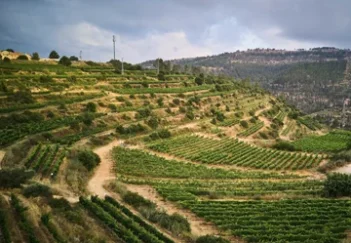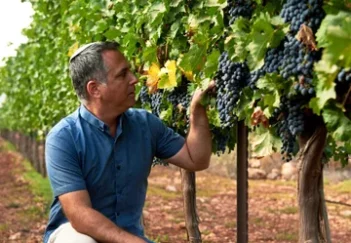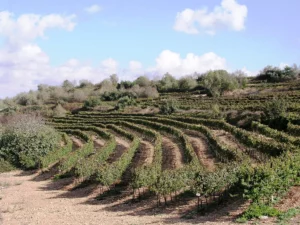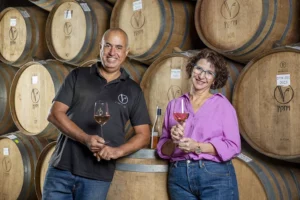When all the talk is of quality Israeli wines which win prizes worldwide, you will be surprised, at how much grape juice and Kiddush wine is still being produced these days.
Israel produces approximately 50 million bottles a year from wine grapes. However a surprising ten million bottles of this is grape juice. These are grape juices usually made from wine grapes, marketed in glass bottles and sold on the wine shelves in Israeli supermarkets. I say ‘wine grapes’ because once wine was made from wine grapes (Cabernet, Merlot etc) and grape juice was made from food or table grapes but these days there are enough wine grapes spare. Producing grape juice is a great way of using excess grapes.
Grape juice really came in its own with the anti-alcohol movement of the 20th century which spawned Prohibition in America. The temperance movement was convinced that partaking of alcohol including wine, was a sin. Many thought that whenever the word Tirosh was used in the Bible it referred to grape juice and not new wine. It was an interpretation based on wishful thinking. Grape juice is but a short stepping stone on the way to wine and then wine vinegar. Certainly in Biblical times they did not have the techniques to preserve grape juice. Harvest grapes and naturally all they want to do is ferment. There are yeasts on the skin of the grapes and in the air that can’t wait to start fermentation. Just try and stop them. Making wine was then a way of saving the product. Leaving it as grape juice would have been impossible.
Of course when pasteurization was invented by Louis Pasteur, an American clergyman named Welch adapted the techniques to allow him to produce a commercially stable grape juice and a new market was born. Today, the giant of kosher grape juice in America is Kedem. They started to make their grape juice in the 1950’s, often using the Concord grape, so beloved by the American palate. Their grape juice has remained the choice of religious Jews in America, despite attempts of others to take a share of the market.
In Israel, the main grape juice is the Carmel Tirosh produced by Carmel Winery since the 1930’s. It is the largest brand in the Israeli ‘wine’ market. Until recently it was known simply as Tirosh. For consumers the word Tirosh meant Carmel. However, in the 2000’s exclusive use of the name was challenged in court and now every grape juice producer has a product named Tirosh.
Just as Americans prefer the Kedem Grape Juice above all others, the Israelis prefer the Carmel taste, but it has become a more competitive business. Other wineries are today producing large quantities of grape juice including Arza, Hacormim, Jerusalem, Segal, Teperberg and Zion. The Carmel Tirosh though, remains the Rolls Royce of Israeli grape juices. It is arguably their most famous product in Israel, which has always caused problems image wise. They make very good wines today, and no quality winery wants their grape juice to be their most well-known product!
Carmel Tirosh is made 100% from wine grapes with no water, sweetener or coloring agent added. The red, (or rose as it may be more accurately described), is made mainly from Carignan sometimes with small amounts of Argaman and Petite Sirah, whilst the white is made from Colombard and Muscat of Alexandria. It is a product that families have grown up with (‘yayin for yeladim’ – wine for children) and grownups who wish to avoid the alcohol or over sweetness of kiddush wine, will continue to use it for Shabbat and festivals. It is the ultimate family product.
The other product is Kiddush or sacramental wine. Approximately four million bottles of Kiddush wine are produced annually In Israel. This is 10 % of the total amount of wine produced. This market sector is dominated by massive brands that have nurtured Jews over a lifetime of Seders, Shabbats and Festivals. Who has not heard of Manischewitz , Mogen Dovid or Kedem in America or Palwin in Britain These are brands with a big following. However, arguably the most famous Israeli Kiddush Wine is Konditon.
Konditon is a word that comes up in the history of Greek and Roman wine, as well as in the Jewish literature. It was a word to describe a spiced wine. In the 1860’s the Shor family decided to produce a Konditon style wine again. In those days wine was not bottled but sold in small casks. There were no labels or kashrut certificates. You bought from someone reputable whom you knew. When bottling and labelling became the norm, Konditon became not just a style of wine, but a brand.
The wine was flavored and sweetened, but this was not new. This is what they did in Biblical times to preserve the wine and make it tasty. Wine has been made this way for thousands of years.
Hacormim is today managed by Eli Shor, a charming, kind man with boundless enthusiasm. He has a winemaker, but Konditon is his baby. He delights in describing how he flavors the wine, building the flavor. Everything is designed to recreate the wines written about in the ancient sources, and by so doing, continuing the Shor family tradition.
The traditional, classic Konditon, is fortified with brandy to roughly 14% alcohol. Its parchment like label was designed by a Bezalel artist depicting scenes from Masada & Kumran. This retails for just under 30 shekels. It is most regularly used as a Kiddush wine, but Eli bristled when I said this, and said that they prefer to categorize it as a dessert wine.
Now there is a new prestige, de-luxe edition, the Konditon 18 which comes in an attractive, stylish package. This is as a fortified dessert wine. It is made from a blend of Caladoc, Argaman, Carignan, Petit Verdot and Muscat Hamburg. It has spices from the Jerusalem area added, along with a touch of Etrog zest, also Silan (date honey) which provides the sweetness and brandy aged in the winery’s own cellar which provides the alcohol. The final wine reaches 18% alcohol, hence the name and it is matured for 36 months in oak barrels. It comes in a handsome presentation box and costs 80 shekels.
Hacormim tell the story of how my distinguished forbear, Sir Moses Montefiore, visited the Shor Winery and it was this that persuaded him to invest in Jerusalem. Visit the winery and you will still see his parents Yechiel & Nechama still coming to work, well past retirement age. When I visited recently, Nechama, sharp as a button, said : “Oh, a Montefiore once visited us 25 years ago.” What a memory! It was me! When I made Aliya I arrived on their doorstep, eager to learn about the different Israeli wines.
Loving history like I do, I especially appreciate the use of the old Shor family logo on the labels. A nice touch. The other members of the family have spawned new boutique wineries to leave the liquid religion image behind. Zion Winery begat 1848 Winery and from Arza Winery came forth Hayotzer. Hacormim though, went retro and have gone back to the old family logo, Shorr 1848 (spelt with two r’s then) for their Konditon wines.
Carmel was Israel’s first commercial winery, founded by the Rothschild family in the 1880’s. The Shor family founded Israel’s first recorded winery in 1848 in the Old City of Jerusalem.
Carmel’s growers are now in their sixth generation. These are largely the same families that planted Carmel’s first vines. They were the owners of the cooperative and now remain part owners. How rare is it for shareholders of a company to stay the same over 130 years The Shor family is in its seventh generation. Two of my children are in the wine trade. That is a mere two generations in this business. How special it is that the Shor family are still making wine after nearly 170 years. The Carmel Tirosh and Hacormim Konditon are like liquid time capsules representing the tradition and history of the wine growing families of Carmel and the winemaking Shors. Here’s hoping that they continue for many more generations!


















